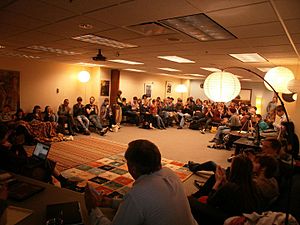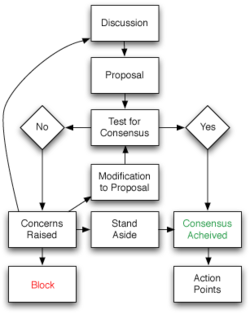Consensus facts for kids

Consensus decision-making is a special way for groups to make choices together. It means everyone in the group works to find a decision they can all support. Even if it's not someone's absolute favorite idea, they agree to go along with it for the good of the whole group.
The word "consensus" comes from a Latin word meaning "to feel together." It describes both the final decision and the process of reaching that decision. This method focuses on how groups talk things over and agree on a choice. It also looks at how using this process affects people and the group.
Contents
Why Use Consensus?
Consensus decision-making aims to make decisions in a very specific way. It tries to get everyone on board with the final choice.
Working Together for Decisions
- Seeking Agreement: The main goal is to get as much agreement as possible from everyone.
- Collaborative: People work together to create a shared idea. They shape it until it addresses everyone's concerns.
- Cooperative: Everyone tries to find the best decision for the whole group. They don't just push for their own ideas.
- Fair for Everyone: All group members should have an equal say. Everyone gets a chance to suggest ideas and change them.
- Including Everyone: As many people as possible who are affected by the decision should be part of the process.
- Active Participation: The process encourages everyone to share their thoughts and be involved in making the decision.
How Consensus is Different
Consensus decision-making is a different way to make choices compared to common methods. Many groups use rules like those in Robert's Rules of Order. These rules often lead to decisions made by a majority vote. This means more than half the group agrees.
Problems with Majority Vote
Critics say that majority voting can sometimes cause problems. It can lead to arguments and groups splitting into "sides." This might hurt relationships between group members. It can also make it harder for everyone to work together later, especially if the decision was very close.
Benefits of Consensus
Consensus decision-making tries to avoid these problems. People who support consensus say it leads to better results:
- Better Decisions: When everyone's ideas are included, the final plan can be stronger. It might address more possible problems.
- Easier to Follow Through: When everyone feels heard and agrees, they are more likely to help carry out the decision.
- Stronger Group Bonds: Working together in a cooperative way can make the group feel more connected. It can also improve friendships within the group.
How Decisions Are Approved
The level of agreement needed to make a decision final is called a "decision rule." Different groups use different rules for consensus.
Levels of Agreement
Here are some ways groups might decide:
- Everyone Agrees: Every single person must agree to the decision.
- Everyone Consents: Everyone agrees to support the decision, even if they don't love it.
- Almost Everyone Agrees: Maybe one or two people can disagree, but everyone else must agree.
- Super Majority: A very large percentage of the group, like 90%, 80%, or two-thirds, must agree.
- Simple Majority: More than half the group agrees (this is less common in strict consensus).
- A Small Group Decides: An executive committee or one person makes the final choice (this is not true consensus).
In groups that need everyone to agree or consent, if even one person strongly objects, they can "block" the decision. This means the decision cannot go forward. These groups use "consensus" to mean both the discussion process and the rule that everyone must agree.
Other groups use a consensus process to get as much agreement as possible. But they might allow decisions to be finalized without everyone agreeing. In these cases, someone who has a strong objection might still have to accept the decision.
Related pages
Images for kids
-
A general assembly at Occupy Wall Street (2011) where people aimed to establish consensus.
See also
 In Spanish: Consenso para niños
In Spanish: Consenso para niños





